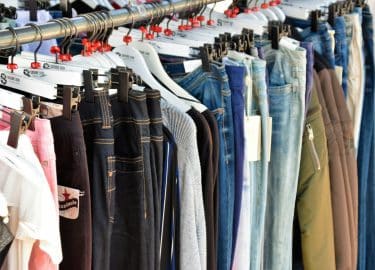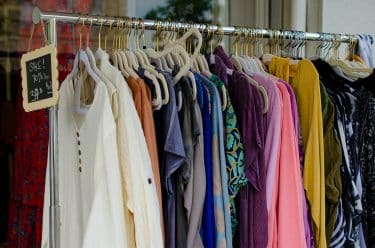A battered bag, a worn-down shoe, a cast-off top – thrifting promises a gentler kind of consumerism, one rooted in restraint rather than impulse, making it a visible marker of sustainability. Over 40% of Gen Z consumers buy second-hand to reduce their environmental impact. Online, it’s framed as the ethical antidote to fast fashion. In reality, it’s wrapped in trend cycles, curated racks, and second-hand price tags that deceptively resemble originals.
Regardless, thrifting has gained popularity in recent years for good reason. It offers an affordable way to shop while reducing demand for new clothing production. In a world where fast fashion is constantly criticised for its toll on the environment, thrifting presents an alternative that feels conscious and corrective. It allows clothing to be reused instead of discarded, and extends the life of garments that might otherwise have ended up in landfill.
For many young people, it feels like a genuine way to align their personal choices with their core values, be it environmentalism, individuality, or financial practicality. Instead of buying mass-produced, trend-driven items, Gen Z now seek unique pieces that express identity and reduce the guilt of consumption.
However, the idea that thrifting is inherently sustainable, ethical, or accessible deserves closer scrutiny. As it becomes more mainstream and commercialised, thrifting often reproduces the same problems it was meant to resist, from overconsumption and waste, to pricing and aesthetics disguised as ethics.
Sanjana, a 22-year-old psychology student at Singapore’s Nanyang Technological University (NTU), first started thrifting in 2020, drawn in by the promise of both style and sustainability. ‘It felt good to put my beliefs into my money,’ she explained. ‘I’d rather spend $20 on a thrifted piece than $20 at Cotton On. I was willing to spend even more, actually.’ She was influenced by the slow fashion movement, which was gaining traction online. ‘Back then, it was more about sustainability. Now it’s become more about putting outfits together, and less about where the clothes come from.’
Like many others, she believed in the idea that thrifting offered an ethical, slower-paced alternative, but her views have evolved. ‘Nowadays, I’m not sure if it really aligns with my values anymore.’
Thrifting has become the default example of ethical consumption. Sanjana’s views reflect how for many, buying second-hand feels like a conscious choice, one that’s morally sound. Thrifting has come a long way from its origins in societies where lower-income communities practiced barter systems and repurposed clothing items as a necessity. In recent years, it has become a cultural movement, especially among Gen Z. What used to be dismissed as “second-hand” is now rebranded as “vintage”.
For a generation raised on climate dread, spiralling living costs, and an internet full of adverse news, thrifting provides a rare kind of relief. It allows people to consume without guilt, a way to shop without feeding the problem. Unlike fast fashion’s mundane uniformity, second-hand clothes carry the promise of individuality. They suggest intention, identity, and resistance, whether or not any of that is true.
Social media platforms like TikTok and Instagram have transformed thrifting into a curated lifestyle. Thrift hauls, outfit transitions, and second-hand styling guides rack up millions of views. For example, with over 1.5 million views on a single clip, Brooklyn Karasack became viral for repurposing vintage clothing into trendy new looks, a makeover format now familiar across the app.
Resale platforms like Depop and Carousell further allow young people not just to thrift, but to resell and monetise thrifted fashion. Reflecting this shift, by 2030, the second-hand fashion market is expected to double in size compared to fast fashion. This growth is driven by the increasing accessibility of platforms like ThredUp, and community events like flea markets or thrift pop-ups.
In Singapore, second-hand shopping has grown into a full-blown weekend experience. Instagram thrift accounts operate like micro-businesses, and curated pop-ups pull in large Gen Z crowds with music, food, and mood lighting. Thrifting is no longer just functional, it’s fashionable, even aspirational. This shift, while understandable, raises questions about what we are really doing when we buy second-hand: rescuing clothes from waste, or simply repackaging the urge to buy.
Thrifting is often seen as an easy win for sustainability. It takes existing clothes and puts them back into circulation, supposedly reducing demand for new production. This is the core claim behind most thrift marketing and content. But as thrifting culture has gained momentum, the sustainability message became increasingly simplified: second-hand clothing means less demand for new production, which means less pollution, water usage, and waste. Yet, like most things that spread too easily, this story has smoothed over a few inconvenient details. The reality, as always, is more complicated.
Not all donated or thrifted items get worn again. In fact, a large proportion of second-hand clothing, especially in curated thrift settings, is ultimately discarded. Many thrift businesses buy clothing in bulk, unsorted and priced by weight, before handpicking a small fraction for resale. What doesn’t meet aesthetic standards is either re-exported, passed along to donation centres, or discarded entirely. Most of it rarely makes it into someone’s wardrobe. Some of it was never meant to.
Sanjana, NTU student, has seen this pattern unfold. ‘They say they’re extending the life of clothes,’ she said. ‘But I’ve seen the same brands, the same tags, pop up again and again. You realise it’s just circulating. The rest gets left behind.’ She added that it becomes hard to see how buying something second-hand genuinely prevents wastage, especially when stores restock weekly and run on trend cycles.
Beyond the discarded clothing lies the issue of transport. Many thrift shops in Singapore and Southeast Asia import their inventory from the United States, Japan, or Europe. The logistics – shipping, storage, sorting – create an environmental burden that is rarely acknowledged. Clothes pass through multiple warehouses and pairs of hands before ending up on a “curated” rack. If they don’t sell, the process starts again. All of this happens under the banner of low-impact living.
Take, for example, the journey of a single thrifted shirt. It’s donated in the U.S., shipped to a warehouse in Malaysia, sorted by style and condition, picked up by a Singapore-based reseller, and eventually sold in a curated boutique in Tiong Bahru. If it doesn’t sell, it is rotated out and shipped again. Every step involves fuel, packaging, labour, and time. The carbon footprint may be lower than producing new clothing, but it’s far from zero.
Globally, the waste from second-hand clothing ends up somewhere. In Ghana, about 40% of used garments are dumped in landfills or burnt in open-air sites. In Chile’s Atacama Desert, mountains of unsellable fast fashion sit under the sun, never decomposing. These items were once marketed as recyclable, ethical, or part of a circular economy. Yet, most of them reached no second owner. They reached the end of a system that has learned how to dispose of things faster than it can reuse them. This causes entire communities to deal with the environmental impact of unsold fast fashion and second-hand waste.
Waste is not the only issue. Even as thrifting promises to shift the way we consume, it often ends up encouraging the same patterns it set out to fix. Once considered the antidote to overconsumption, it seemed to offer a slower, more intentional alternative to the churn of fast fashion. Today, it increasingly fuels the same consumption habits it was supposed to challenge.

The rise of thrift hauls online are a clear marker of this shift. Videos featuring bags of clothing, quick outfit changes, and dramatic before-and-after transformations are now a staple on TikTok and Instagram. The format has become predictable, the content highly shareable. The message that comes through is clear: it is okay to buy more, as long as it is second-hand.
Sanjana admitted that she had been drawn into this mindset. ‘There were times I knew I didn’t need something, but it’s hard to be in a room full of cute clothes and have restraint,’ she said. ‘It felt harmless. But it wasn’t really different from fast fashion, just labelled differently.’ She also pointed out how curated stores encourage browsing with a different kind of justification. Essentially, the impulse to purchase remains, but the guilt is numbed.
The tote bag analogy, often mentioned in sustainability discussions, applies neatly here. Reusable canvas totes were originally introduced to cut down on plastic waste. Soon after, they became fashion statements. People started collecting them from cafés, museums, and events, only to display them as shelf pieces, or stash them away unused. Many were eventually discarded. The problem wasn’t the tote bag itself. It was the uncritical belief that excess is harmless when it comes with good intentions.
Thrifting has followed a similar path. The practice started as a practical and often necessary act. Gradually, it became a lifestyle, then a form of content. Some influencers no longer buy second-hand for personal use, but to resell, photograph, or build a brand. In turn, many consumers now thrift to participate in a trend rather than out of need.
None of this makes individual thrifters inherently irresponsible, but the shift in behaviour matters. Thrifting is no longer simply about reuse, it has developed its own version of fast cycles: constant new stock, rapid rotation, trend-based pricing, curated drops. Though the aesthetics are different, the pace feels particularly familiar.
Alongside shifting consumption patterns, the economic role of thrifting has undergone its own quiet transformation. Thrift stores have long been associated with affordability. For decades, they offered clothing at a fraction of retail prices. This made them important not just for sustainability, but for access. Today, this function is under pressure. In Singapore, many second-hand stores now market themselves as “curated” or “boutique-style.” They select items based on trend categories, such as ‘clean girl’, ‘cottagecore’, ‘Y2K’, and price accordingly. A blazer might cost $40, a basic tee $25. The same pricing logic applies across flea markets, pop-ups, and online resale pages.
Sanjana has noticed the shift. ‘There’s a huge difference between a thrift shop that sells what it gets and one that curates,’ she said. ‘It’s no longer about affordability. It’s about aesthetics. It feels like they’re selling a look, not clothes.’ Some stores, she added, even filter based on what will photograph well for Instagram. Items that are too worn, plain, or off-trend rarely make it onto the rack.
This shift has introduced a new set of barriers. While some buyers can still access affordable options, the curated market increasingly targets middle-class consumers looking for ethical alternatives that align with their personal brand. The experience has become more performative. Second-hand shopping is now part of a larger narrative about identity, values, and visual taste. That narrative, however, comes at a cost.
The result is a quiet displacement of the communities that once relied on thrift stores. Another NTU student described it as “retail gentrification”. He explained how items once dismissed as unfashionable or low-value, like carpenter pants or boxy jackets, are now rebranded as vintage essentials. ‘It was never meant to be a trend’ he said. ‘But now, everything from Carhartt to ripped T-shirts, is being sold as an aesthetic. And worse, fast fashion has started mimicking thrifted styles. It’s all been commodified.’
The idea that thrifting is financially inclusive no longer holds. The more it is styled and streamlined, the less accessible it becomes. It may still be second-hand, but the economics feel thoroughly conventional.
Social media plays a central role in that commodification. Influencers often frame thrifting as a morally superior act: an identity, not just a behaviour. Haul videos, outfit shots, monthly closet clean-outs, all feed the same attention economy that drives fast fashion marketing. Some influencers partner with curated resale platforms and post professionally styled lookbooks. Gone are the dusty racks and mismatched sizing of traditional thrift stores. In their place are boutique displays and “drops” of hand-selected items. The reality of thrifting: time, patience, inconsistency, doesn’t trend well.
Even so, the appeal of second-hand fashion remains strong for many consumers. Compared to traditional retail, the second-hand economy does offer certain practical and emotional advantages. For many, it represents a more thoughtful way to shop. For those who thrift responsibly, the environmental benefit is real, particularly when purchases are rare, considered, and worn for longer than a single trend cycle.
Despite rising prices in curated thrift stores, second-hand shopping can still be cheaper than retail for those who know where to look. Community-led initiatives, donation-based shops, and non-curated spaces continue to provide access to affordable clothing, even if they receive less attention than trend-focused thrift businesses. The infrastructure isn’t completely broken, it’s just uneven.
Then there is the matter of alternatives. The fast fashion industry’s dominance hasn’t disappeared, it has simply adapted. For many Gen Z consumers, including Sanjana, brands like Shein or H&M are still a regular fallback, especially for basics. ‘For sizing especially,’ she explained, ‘Shein is one of the places that actually has sizing options. I think a lot of people face that issue.’ As such, access to clothing that fits, that ships quickly, and that doesn’t demand time spent digging through racks, still holds real appeal.
Even curated thrift stores reflect this reality. It’s common to find items from Shein or Cotton On resold in second-hand spaces, often at higher prices than their original retail tags. When fast fashion shows up in thrift stores and sells as vintage, the ethical lines start to blur. The line between conscious shopping and aesthetic performance becomes harder to draw.

This doesn’t make thrifting a failure, but it complicates the claim that it’s a catch-all solution. For some, it’s still the best available option. For others, it’s a workaround, more appealing than fast fashion, but shaped by many of the same incentives. In both cases, the belief that thrifting is inherently better creates its own kind of complacency.
Sustainable behaviour does not come from labels or platforms alone, it comes from the choices made within them. In that sense, thrifting is neither saviour nor scam. It is simply a system, one that can be used thoughtfully, or not.
For Sanjana, what began as a decision grounded in her values, now feels far less straightforward. Thrifting once offered a way to shop with intention, an alternative to fast fashion that aligned with how she wanted to live. But the culture has shifted. ‘It’s become really hard to say thrifting aligns with my values,’ she said.
She still thrifts, but with more hesitation. She’s buying less, repairing more, and choosing swaps when she can. The excitement has given way to something slower, quieter, and more deliberate.
Her habits haven’t disappeared, but the certainty that once came with them has. In a culture that increasingly rewards aesthetics over substance, that shift might be the most honest response possible.
None of this means thrifting is inherently harmful, but it isn’t undoubtedly good either. Its impact depends on how it’s practiced, by whom, and within what kind of system. At its best, second-hand shopping can extend the life of garments, reduce demand for new production, and provide affordable options outside the retail cycle. At its worst, it mimics the same problems it was meant to resist: overconsumption, exclusion, and waste, just dressed in better lighting.
Sanjana sees this contradiction too. ‘I think thrifting started off meaning well,’ she said. ‘But now it’s kind of become more sinister, like greenwashing. It disguises itself as sustainable, but there’s so many issues behind it.’ For her, the shift from slow fashion to curated hype has made it harder to participate ethically. ‘Sometimes I see those massive thrift hauls online, and it actually upsets me. You don’t need that many clothes. What are you doing? Who is this helping?’
Her discomfort reflects a larger social pattern. Cultural narratives often flatten complex systems into slogans. Once those slogans start to feel good, they become harder to challenge. Platforms like TikTok and Instagram accelerate this process rewarding clarity over nuance, and aesthetic over context. Algorithms don’t question whether second-hand shopping is sustainable, they just amplify the voices that say it is.
Maybe the real takeaway isn’t about thrifting at all. It’s about how easily we accept comforting stories, especially when they are well-marketed, neatly packaged, and just plausible enough to escape scrutiny.



